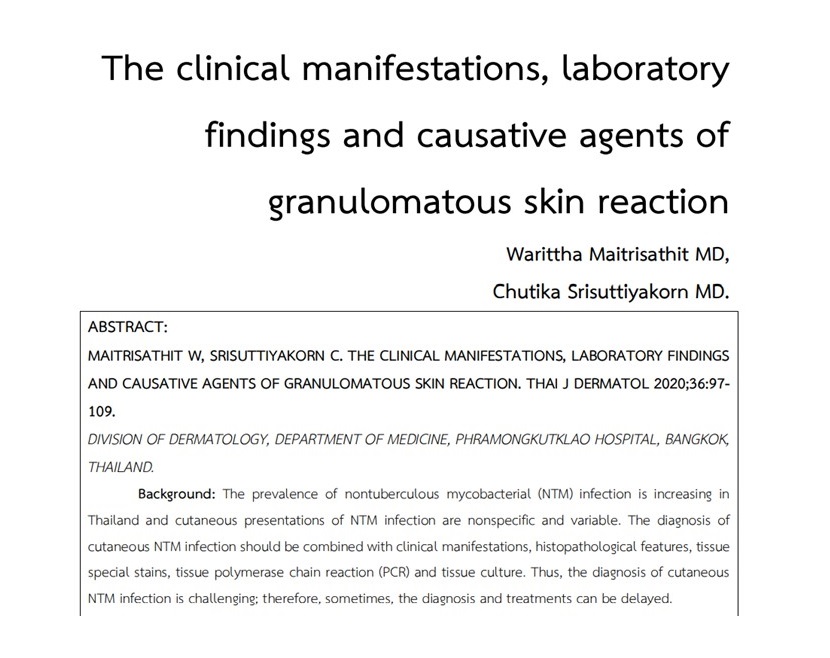The clinical manifestations, laboratory findings and causative agents of granulomatous skin reaction
Keywords:
Nontuberculous mycobacteria, granulomatous skin reactionsAbstract
Background: The prevalence of nontuberculous mycobacterial (NTM) infection is increasing in Thailand and cutaneous presentations of NTM infection are nonspecific and variable. The diagnosis of cutaneous NTM infection should be combined with clinical manifestations, histopathological features, tissue special stains, tissue polymerase chain reaction (PCR) and tissue culture. Thus, the diagnosis of cutaneous NTM infection is challenging; therefore, sometimes, the diagnosis and treatments can be delayed.
Objective: This study would like to improve the diagnosis when there was no evidence of organism from tissue biopsy, this study would like to investigate the correlations of history, clinical manifestations and histopathological features in the cases of tissue biopsy were granulomatous reaction and the final diagnosis as cutaneous mycobacterial infection. The secondary outcome is to investigate the correlation of history, clinical manifestation and histopathology between NTM granuloma and the other causes of infectious granuloma.
Materials and Methods: A retrospective study of the patients with histopathological features as granulomatous reaction and suspected of cutaneous mycobacterium infection from history and clinical manifestations were obtained from the Division of Dermatology, Phramongkutklao Hospital between January 2014 and December 2016.
Result: All the 30 cases with skin biopsy compatible with granulomatous reaction were included in this study. Of the 30 cases, eight cases (26.67%) had diagnosis as NTM infection, seven cases (23.33%) had diagnosis as suspected NTM infection and 15 cases (50%) had other diagnoses. The male to female ratio was 2:3. The mean age at diagnosis was 54.4 years (range 16-94).
The history of suspected cutaneous chronic infection was significant higher in the NTM/suspected NTM infections group compared to the group with other diagnoses. The location of the lesions in NTM/suspected NTM infection was more common on extremities. All the patients presented with red-colored nodule, papule or plaque which has no statistic significant between each group.
Most of granulomatous patterns in our study are suppurative and mixed cell granuloma. There was no correlation between histopathological findings and the demonstration of organism in tissue specimens. The tissue AFB stain in NTM-infection group is positive in 37.5% (3/8 cases) which 2 of the 3 AFB-positive cases had immunocompromised status. Tissue culture was positive in 62.5% of the NTM-infection group which M. abscessus was the most common causative organism. The mean duration of treatments in NTM/suspected NTM infections was 6 months.
Conclusion:Although the tissue special stains, tissue PCR or tissue culture are the most effective diagnostic tools, the rate of positivity is low in our study. The diagnosis should be suspected in the patients with suspicious history such as history of trauma, aquatic-relate injury. The prompt treatment with broad-spectrum antibiotics should be started in suspicious patients.
References
Ferringer T. Granulomatous and histiocytic diseases. In: Elston DM, Ferringer T, editors. Dermatopathology. 2nd ed. USA: Elsevier 2014.p. 172.
High WA, Tomasini CF, Argenziano G, Zalaudek I. Basic principles of dermatology. In: Bolognia JL, Schaffer JV, Cerroni L, editors. Dermatology. 4th ed. USA: Elsevier 2018.p.20.
Johnston RB. Granulomatous reaction pattern. In: Johnston RB, editor. WEEDON’s skin pathology essentials. 2nd ed. USA: Elsevier 2017.p.134-62.
Mahaisavariya P, Chaiprasert A, Khemngern S, et al. Nontuberculous mycobacterial skin infections: clinical and bacteriological studies. J Med Assoc Thai 2003;86:52-60.
Falkinham JO 3rd. Surrounded by mycobacteria: nontuberculous mycobacteria in the human environment. J Appl Microbiol 2009;107:356-67.
Atkins BL, Gottlieb T. Skin and soft tissue infections caused by nontuberculous mycobacteria. Curr Opin Infect Dis 2014;27:137-45.
Gonzalez-Santiago TM, Drage LA. Nontuberculous Mycobacteria: Skin and Soft Tissue Infections. Dermatol Clin 2015;33:563-77.
Falkinham JO 3rd. Nontuberculous mycobacteria in the environment. Clin Chest Med 2002;23:529-51.
Holland SM. Nontuberculous mycobacteria. Am J Med Sci 2001;321:49–55.
Field S K, Cowie R L. Lung disease due to the more common nontuberculous mycobacteria. Chest 2006;129:1653-72.
El-Zammar OA, Katzenstein AL. Pathological diagnosis of granulomatous lung disease: a review. Histopathology 2007;50:289-310.
Min KW, Ko JY, Park CK. Histopathological spectrum of cutaneous tuberculosis and non-tuberculous mycobacterial infections. J Cutan Pathol 2012;39:582-95.
Park DY, Kim JY, Choi KU, Lee CH, Sol MY, Suh KS. Comparison of polymerase chain reaction with histopathologic features for diagnosis of tuberculosis in formalin-fixed, paraffin-embedded histologic specimens. Arch Pathol Lab Med 2003;127:326-30.
Bartralot R, Pujol RM, García-Patos V, et al. Cutaneous infections due to non-tuberculous mycobacteria: histopathological review of 28 cases. Comparative study between lesions observed in immunosuppressed patients and normal hosts. J Cutan Pathol 2000;27:124-9.
Chairatchaneeboom M, Surawan T, Patthamalai P. Nontuberculous mycobacterial skin infection: A 20-year retrospective study. Thai J Dermatol 2018;34:111-29.
Hsiao CH, Tsai TF, Hsueh PR. Characteristics of skin and soft tissue infection caused by non-tuberculosis mycobacteria in Taiwan. Int J Tuberc Lung Dis 2011;15:811-7.
Kontoyiannis PD, Koons GL, Hicklen RS, et al. Insect Bite-Associated Invasive Fungal Infections. Open Forum Infect Dis 2019;6:ofz385.
Wallace JR, Mangas KM, Porter JL, et al. Mycobacterium ulcerans low infectious dose and mechanicaltransmission support insect bites and puncturing injuries in the spread of Buruli ulcer. PLoS Negl Trop Dis 2017;11:e0005553.
Rodríguez G, Ortegón M, Camargo D, et al. Iatrogenic Mycobacterium abscessus infection: histopathology of 71 patients. Br J Dermatol 1997;137:214–18

Downloads
Published
How to Cite
Issue
Section
License
เนื้อหาและข้อมูลในบทความที่ลงตีพิมพ์ในวารสารโรคผิวหนัง ถือเป็นข้อคิดเห็นและความรับผิดชอบของผู้เขียนบทความโดยตรงซึ่งกองบรรณาธิการวารสาร ไม่จำเป็นต้องเห็นด้วย หรือร่วมรับผิดชอบใดๆ
บทความ ข้อมูล เนื้อหา รูปภาพ ฯลฯ ที่ได้รับการตีพิมพ์ในวารสารโรคผิวหนัง ถือเป็นลิขสิทธิ์ของวารสารฯ หากบุคคลหรือหน่วยงานใดต้องการนำทั้งหมดหรือส่วนหนึ่งส่วนใดไปเผยแพร่ต่อหรือเพื่อกระทำการใดๆ จะต้องได้รับอนุญาตเป็นลายลักอักษรจากบรรณาธิการวารสารโรคผิวหนังก่อนเท่านั้น


